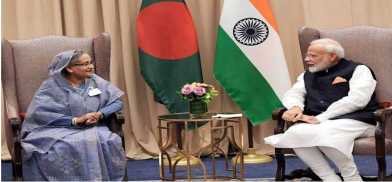Growing Bangladesh-India trade and economic ties creating new opportunities in both countries
Bangladesh’s holistic development is viewed positively by New Delhi, with new opportunities arising along India’s northeastern region

Bangladesh is one of India’s largest trade partners in the region. Bilateral trade grew at an unprecedented 14 percent during Covid-19 -- from $9.46 billion in 2019 to $10.78 billion in 2021.
Bangladesh mainly exports to India readymade garments, jute and jute-processed products, leather-processed products, plastic products, fish, soft drinks, copper and edible oil. It imports rice, raw cotton, onion, motor vehicles, boilers, machinery, milk, dairy products, electronic products and iron. There is huge potential to increase the trade volume.
Bangladesh’s stable economic development is creating new opportunities for India’s northeastern states,. Work on a Comprehensive Economic Partnership Agreement (CEPA) is ongoing. India’s Defense Minister Rajnath Singh has said that India-Bangladesh relations are going through a golden phase. As Bangladesh attains “developing nation” status (from “less developed country” status), India has reiterated its commitment to deepen trade and economic ties as partners rather than as competitors.
India’s northeast
Bangladesh’s holistic development is viewed positively by New Delhi, with new opportunities arising along India’s northeastern region. Bangladesh and India share a 4,096-km (2,545-mile) border, the fifth-longest land border in the world, touching the Indian states of Assam, Tripura, Mizoram, Meghalaya and West Bengal.
According to media reports, Bangladesh may become India’s fourth-largest export destination in FY22, jumping five places in two years. India’s Business Standard newspaper wrote last year that in the first seven months of FY22, exports to Bangladesh grew 81 percent over the same period in the preceding year to $7.7 billion. This makes it India’s fourth-largest export market behind the US, the UAE and China.
Bangladesh is India’s biggest trade partner in South Asia and India is the second biggest trade partner of Bangladesh. Exports from Bangladesh have tripled over the last decade to cross $1 billion in 2018-19. In FY 2019-20, Indian exports to Bangladesh were $8.2 billion and imports $1.26 billion.
The two countries now should concentrate on people-to-people contacts, trade, business and connectivity. India could be a major supplier of yarn and cotton to the garment industry in Bangladesh.
Five core areas
A deeper economic and trade engagement becomes all the more relevant, given the success of the uninterrupted supply chains during the pandemic. An augmented connectivity infrastructure is imperative to actualize the bilateral trade and investment potential between the two countries. Indian Commerce and Industry Minister Piyush Goyal has recognized five focus areas to bolster economic ties – technology, connectivity, entrepreneurship, health and tourism. Bangladesh is important to aid India’s connectivity in the Southeast Asian region through Chittagong and Mongla ports.
Indian and Bangladeshi companies signed agreements worth nearly $10 billion for Indian investment, mainly in the power and energy sectors, during the 2017 visit of Prime Minister Sheikh Hasina to India.
Both India and Bangladesh are working towards holding the first meeting of the India-Bangladesh CEOs Forum to provide policy level inputs in various areas of trade and investment and also to facilitate exchanges among the business communities. Additionally, a bilateral textile industry forum has been constituted to facilitate cooperation in the textile sector.
The electricity grids of India and Bangladesh are interconnected. A Rs 346 crore pipeline project, signed in 2018, will connect Siliguri in West Bengal in India and Parbatipur in Dinajpur district of Bangladesh. The pipeline will enable the two countries to integrate their energy needs.
Covid help
India sent over one crore Covid-19 vaccines to Bangladesh and has extended concessional credit lines of about $8 billion, the highest for any single country. Over 350 Indian companies are registered in Bangladesh.
India and Bangladesh have also signed a MoU for the construction of a high-speed diesel pipeline from Assam to Bangladesh, a joint venture between Numaligarh Refinery Ltd and Bangladesh Petroleum Corp. An initial consignment of 2,200 tonnes of diesel has already been transported from West Bengal to Parbatipur in 50 wagons by the Indian Railways.
Over the past eight years, India has extended three Lines of Credit to Bangladesh, amounting to $8 billion for the development of infrastructure in various sectors including roads, railways, shipping and ports. Additionally, India has provided grant assistance to Bangladesh for various infrastructure projects,, including the construction of the Akhaura-Agartala rail link, dredging of inland waterways in Bangladesh and an India-Bangladesh Friendship Pipeline.
Further, High Impact Community Development Projects (HICDPs) form an important part of India’s developmental assistance to Bangladesh. India has funded 68 HICDPs including academic buildings, cultural centers, skill development and training institutes, student hostels and orphanages.
But there is a huge trade deficit between Bangladesh and India. India should give more duty-free access to Bangladeshi products.
(The writer is a Dhaka-based NGO activist and researcher-writer on international relations. Views are personal. He can be contacted at pathikhasan1141@gmail.com)









Post a Comment